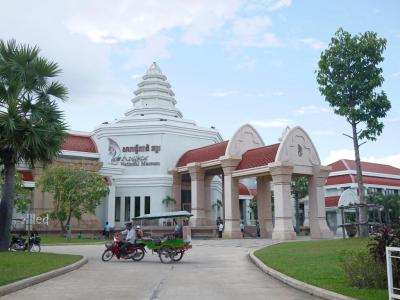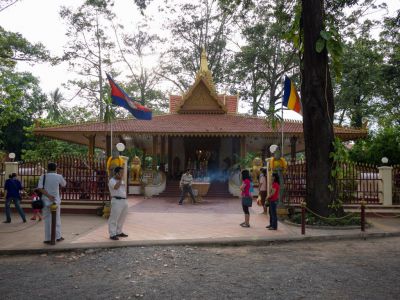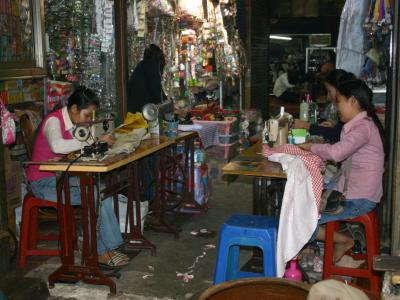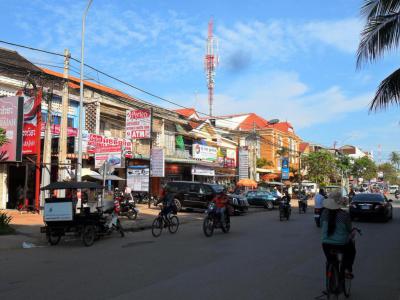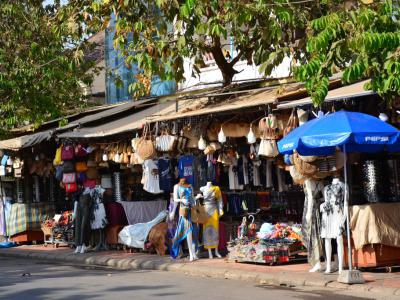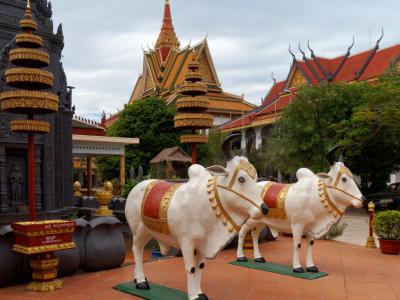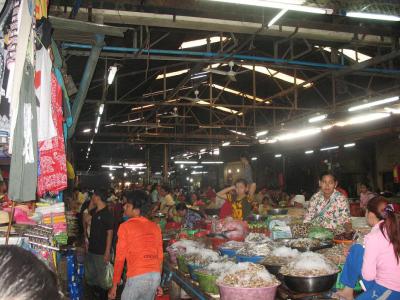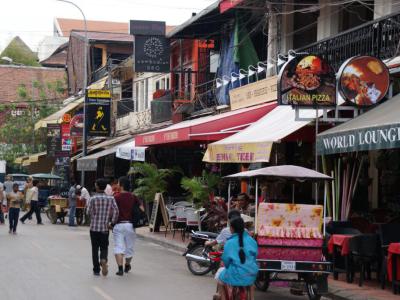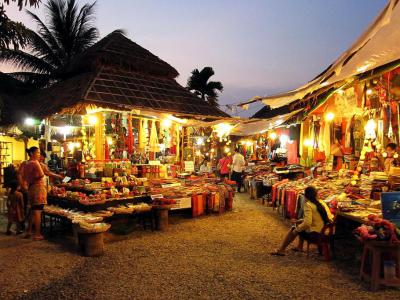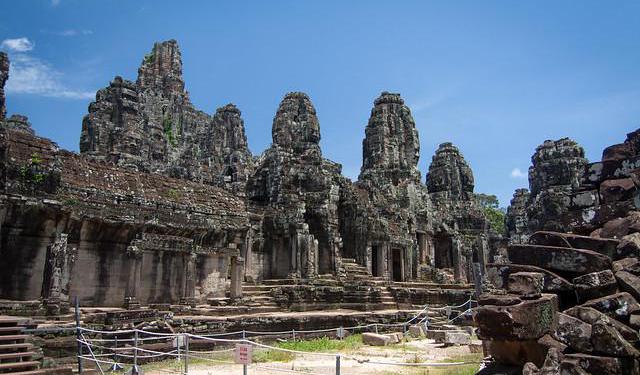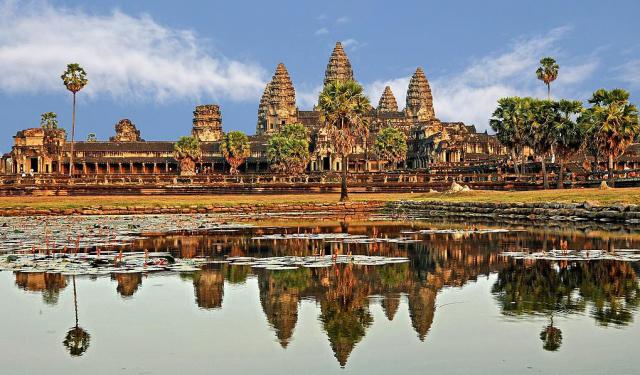
Siem Reap Introduction Walking Tour (Self Guided), Siem Reap
As the gateway to the magnificent Angkor Archaeological Park, Siem Reap holds within its bounds an extraordinary blend of ancient temples, bustling markets, and vibrant neighborhoods.
Siem Reap's history dates back to the 9th century when it emerged as a small village near the Siem Reap River. Its name, meaning "Defeat of Siam," pays homage to a victorious battle fought against the neighboring Thai kingdom during the rule of King Ang Chan. This humble village grew in prominence, largely due to its strategic location near the Angkor temples. Over time, Siem Reap became a bustling hub, attracting pilgrims, traders, and explorers alike.
Siem Reap was part of French Indochina, coming under French rule in the late 19th century. The French influence left an architectural imprint on the city, with charming colonial-era buildings that still stand today.
Angkor National Museum is an enclave of relics and artifacts that offer a glimpse into the region's storied past. Immerse yourself in the charm of the Old French Quarter, where colonial-era architecture stands as a testament to Siem Reap's fusion of cultures. Meander through streets lined with quaint cafes, boutiques, and galleries that echo a bygone era.
The bustling Central Market, where vibrant stalls beckon with a kaleidoscope of goods, offers a snapshot of Cambodian life and culture. Royal Fortune Buddha Temple is a haven of tranquility amidst the city's energy. Admire the intricate architecture and take a moment to reflect on this spiritual sanctuary.
Conclude your odyssey on the vibrant Pub Street, the epicenter of Siem Reap's dining and entertainment with restaurants, bars, and a lively atmosphere. It's the perfect place to unwind after a day of exploration.
As you tread the streets of Siem Reap, you're not just walking; you're tracing the footsteps of generations that have contributed to the city's evolving story. From its humble beginnings to its present-day vibrancy, Siem Reap invites you to immerse yourself in its captivating narrative. Take this self-guided journey to celebrate the city's past, embrace its present, and anticipate the promise of tomorrow.
Siem Reap's history dates back to the 9th century when it emerged as a small village near the Siem Reap River. Its name, meaning "Defeat of Siam," pays homage to a victorious battle fought against the neighboring Thai kingdom during the rule of King Ang Chan. This humble village grew in prominence, largely due to its strategic location near the Angkor temples. Over time, Siem Reap became a bustling hub, attracting pilgrims, traders, and explorers alike.
Siem Reap was part of French Indochina, coming under French rule in the late 19th century. The French influence left an architectural imprint on the city, with charming colonial-era buildings that still stand today.
Angkor National Museum is an enclave of relics and artifacts that offer a glimpse into the region's storied past. Immerse yourself in the charm of the Old French Quarter, where colonial-era architecture stands as a testament to Siem Reap's fusion of cultures. Meander through streets lined with quaint cafes, boutiques, and galleries that echo a bygone era.
The bustling Central Market, where vibrant stalls beckon with a kaleidoscope of goods, offers a snapshot of Cambodian life and culture. Royal Fortune Buddha Temple is a haven of tranquility amidst the city's energy. Admire the intricate architecture and take a moment to reflect on this spiritual sanctuary.
Conclude your odyssey on the vibrant Pub Street, the epicenter of Siem Reap's dining and entertainment with restaurants, bars, and a lively atmosphere. It's the perfect place to unwind after a day of exploration.
As you tread the streets of Siem Reap, you're not just walking; you're tracing the footsteps of generations that have contributed to the city's evolving story. From its humble beginnings to its present-day vibrancy, Siem Reap invites you to immerse yourself in its captivating narrative. Take this self-guided journey to celebrate the city's past, embrace its present, and anticipate the promise of tomorrow.
How it works: Download the app "GPSmyCity: Walks in 1K+ Cities" from Apple App Store or Google Play Store to your mobile phone or tablet. The app turns your mobile device into a personal tour guide and its built-in GPS navigation functions guide you from one tour stop to next. The app works offline, so no data plan is needed when traveling abroad.
Siem Reap Introduction Walking Tour Map
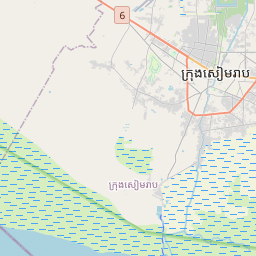





Guide Name: Siem Reap Introduction Walking Tour
Guide Location: Cambodia » Siem Reap (See other walking tours in Siem Reap)
Guide Type: Self-guided Walking Tour (Sightseeing)
# of Attractions: 9
Tour Duration: 2 Hour(s)
Travel Distance: 2.8 Km or 1.7 Miles
Author: vickyc
Sight(s) Featured in This Guide:
Guide Location: Cambodia » Siem Reap (See other walking tours in Siem Reap)
Guide Type: Self-guided Walking Tour (Sightseeing)
# of Attractions: 9
Tour Duration: 2 Hour(s)
Travel Distance: 2.8 Km or 1.7 Miles
Author: vickyc
Sight(s) Featured in This Guide:
- Angkor National Museum
- Preah Ang Chek Preah Ang Chorm Shrine
- Made in Cambodia Market
- Sivatha Boulevard and the Old French Quarter
- Phsar Leu Thom Thmei (Central Market)
- Wat Preah Prom Rath (Royal Fortune Buddha Temple)
- Phsar Chas (Old Market)
- Pub Street
- Angkor Night Market
1) Angkor National Museum (must see)
The Angkor National Museum stands as a magnificent showcase of the Khmer civilization and the grandeur of Angkor. Upon entering the museum, visitors are treated to themed displays that encompass various eras, religious aspects, and royal elements of the Khmer dynasty.
The experience begins with a short presentation, setting the stage for the subsequent exploration of the museum's treasures. In the Zen-like Gallery of a Thousand Buddhas, visitors are greeted with a splendid collection of Buddha images, creating a serene and meditative atmosphere.
The exhibits cover a wide range of topics, including the pre-Angkorian periods of Funan and Chenla, the reign of the great Khmer kings, the magnificence of Angkor Wat and Angkor Thom, as well as the inscriptions that reveal invaluable historical insights.
Interactive touch-screen videos, accompanied by epic commentary, enhance the museum's presentation, offering visitors a deeper appreciation of the artifacts on display. The museum even allows visitors to experience a panoramic sunrise at Angkor Wat, a memorable and immersive encounter with one of Cambodia's most iconic landmarks.
Among the standout pieces in the collection are a late 12th to early 13th-century seated Buddha protected by a naga, a mythical serpent-being; a 7th-century standing Vishnu from Sambor Prei Kuk in Kompong Thom; and a breathtaking 10th-century lintel from the exquisite Banteay Srei temple.
One of the advantages of visiting the Angkor National Museum is the respite it provides from the heat, as the entire museum is air-conditioned. To enhance the experience, audio tours are available for a nominal fee, providing in-depth explanations and insights into the exhibits.
Allowing approximately two hours to explore the museum thoroughly, visitors can conclude their visit with a stop at the museum's shop and small cafe, providing an opportunity to take home mementos and reflect on the incredible journey through the ancient wonders of the Khmer civilization.
The experience begins with a short presentation, setting the stage for the subsequent exploration of the museum's treasures. In the Zen-like Gallery of a Thousand Buddhas, visitors are greeted with a splendid collection of Buddha images, creating a serene and meditative atmosphere.
The exhibits cover a wide range of topics, including the pre-Angkorian periods of Funan and Chenla, the reign of the great Khmer kings, the magnificence of Angkor Wat and Angkor Thom, as well as the inscriptions that reveal invaluable historical insights.
Interactive touch-screen videos, accompanied by epic commentary, enhance the museum's presentation, offering visitors a deeper appreciation of the artifacts on display. The museum even allows visitors to experience a panoramic sunrise at Angkor Wat, a memorable and immersive encounter with one of Cambodia's most iconic landmarks.
Among the standout pieces in the collection are a late 12th to early 13th-century seated Buddha protected by a naga, a mythical serpent-being; a 7th-century standing Vishnu from Sambor Prei Kuk in Kompong Thom; and a breathtaking 10th-century lintel from the exquisite Banteay Srei temple.
One of the advantages of visiting the Angkor National Museum is the respite it provides from the heat, as the entire museum is air-conditioned. To enhance the experience, audio tours are available for a nominal fee, providing in-depth explanations and insights into the exhibits.
Allowing approximately two hours to explore the museum thoroughly, visitors can conclude their visit with a stop at the museum's shop and small cafe, providing an opportunity to take home mementos and reflect on the incredible journey through the ancient wonders of the Khmer civilization.
2) Preah Ang Chek Preah Ang Chorm Shrine
The Preah Ang Chek Preah Ang Chorm Shrine, situated within the compound of the Royal Residence, is a revered place of worship. The shrine houses two statues known as Preah Ang Chek and Preah Ang Chorm, both of whom hold a dignified status as princesses. These bronze statues were rediscovered in 1950, hidden in the forests around Angkor Thom by Angkor conservation officials. Historical records suggest that the statues were originally kept in the temple of Angkor Wat but were later lost due to the neglect of the temple.
The statues, once discovered, were taken by the infamous predator Dap Chhuon, who was the governor of Siem Reap during the 1950s. Using occult black magic, he carried the heavy statues with ease. Legend has it that the statues warned Dap Chhuon of a plot against him by Prince Norodom Sihanouk, leading him to flee to Thailand but losing his magical powers along the way. Eventually, the cult of Preah Ang Chek and Preah Ang Chorm was reintroduced with the support of Buddhist monks and the province of Siem Reap.
According to the official account, the statues were later found at the bottom of the Siem Reap River and were restored to their rightful home at Wat Damnak. In 1982, a shrine was constructed for the revered "gold Buddhas" opposite Independence Gardens and the Grand Hotel d'Angkor.
Devotees of the shrine believe that Preah Ang Chek and Preah Ang Chorm bestow good fortune upon newlyweds and offer spiritual protection for the entire region of Siem Reap. Each day, an average of about 300 people visit the shrine to make offerings of candles, incense sticks, and lotus flowers as gestures of reverence and supplication to these venerated princesses.
The statues, once discovered, were taken by the infamous predator Dap Chhuon, who was the governor of Siem Reap during the 1950s. Using occult black magic, he carried the heavy statues with ease. Legend has it that the statues warned Dap Chhuon of a plot against him by Prince Norodom Sihanouk, leading him to flee to Thailand but losing his magical powers along the way. Eventually, the cult of Preah Ang Chek and Preah Ang Chorm was reintroduced with the support of Buddhist monks and the province of Siem Reap.
According to the official account, the statues were later found at the bottom of the Siem Reap River and were restored to their rightful home at Wat Damnak. In 1982, a shrine was constructed for the revered "gold Buddhas" opposite Independence Gardens and the Grand Hotel d'Angkor.
Devotees of the shrine believe that Preah Ang Chek and Preah Ang Chorm bestow good fortune upon newlyweds and offer spiritual protection for the entire region of Siem Reap. Each day, an average of about 300 people visit the shrine to make offerings of candles, incense sticks, and lotus flowers as gestures of reverence and supplication to these venerated princesses.
3) Made in Cambodia Market
The Made in Cambodia Market is a must-visit destination for anyone looking to experience the vibrant culture and creativity of Cambodia. Taking place every Saturday, Sunday, and Tuesday in front of the Shinta Mani Resort in Siem Reap, this outdoor market offers a delightful array of live performances, delectable local cuisine, and authentic Cambodian souvenirs crafted by talented local artisans.
One of the highlights of the Made in Cambodia Market is the opportunity to witness live performances that showcase the rich cultural heritage of the country. Traditional music, dance, and theatrical displays transport visitors into the heart of Cambodia's artistic traditions.
Food lovers will also be delighted by the diverse culinary offerings at the market. From aromatic street food stalls to cozy cafes, the Made in Cambodia Market presents a wide variety of tasty local dishes that are sure to tantalize the taste buds. Visitors can indulge in traditional Cambodian delicacies, such as amok (a fragrant fish curry), nom banh chok (Khmer noodles), or num krok (coconut rice pancakes).
When it comes to shopping, the Made in Cambodia Market stands out for its unique and high-quality products. While the goods may be priced slightly higher compared to other markets in Siem Reap, the craftsmanship and attention to detail make them worth the investment. Visitors can browse through a wide range of items including clothing, cosmetics, jewelry, paintings, and toys, all of which reflect the rich cultural heritage of Cambodia. Whether you're looking for traditional silk garments, intricate silver jewelry, or hand-painted artwork, the market offers a treasure trove of souvenirs and gifts to bring home.
One of the highlights of the Made in Cambodia Market is the opportunity to witness live performances that showcase the rich cultural heritage of the country. Traditional music, dance, and theatrical displays transport visitors into the heart of Cambodia's artistic traditions.
Food lovers will also be delighted by the diverse culinary offerings at the market. From aromatic street food stalls to cozy cafes, the Made in Cambodia Market presents a wide variety of tasty local dishes that are sure to tantalize the taste buds. Visitors can indulge in traditional Cambodian delicacies, such as amok (a fragrant fish curry), nom banh chok (Khmer noodles), or num krok (coconut rice pancakes).
When it comes to shopping, the Made in Cambodia Market stands out for its unique and high-quality products. While the goods may be priced slightly higher compared to other markets in Siem Reap, the craftsmanship and attention to detail make them worth the investment. Visitors can browse through a wide range of items including clothing, cosmetics, jewelry, paintings, and toys, all of which reflect the rich cultural heritage of Cambodia. Whether you're looking for traditional silk garments, intricate silver jewelry, or hand-painted artwork, the market offers a treasure trove of souvenirs and gifts to bring home.
4) Sivatha Boulevard and the Old French Quarter
Sivatha Boulevard is a delightful part of the Old French Quarter that exudes a vintage charm, thanks to its well-preserved colonial buildings. Despite the recent developments in the city, these historic structures still stand strong, serving as a testament to the area's rich architectural heritage.
As Siem Reap's main street, Sivatha Boulevard boasts an array of luxurious accommodations, including the elegant Prince d'Angkor Hotel & Spa.
The area surrounding Sivatha Boulevard is also home to numerous upmarket restaurants, trendy shops, and boutiques. Travelers can indulge in a variety of dining options, ranging from local Khmer delicacies to international cuisines, making it a perfect destination for food enthusiasts.
Moreover, the boulevard serves as a hub for shopping enthusiasts, offering a diverse selection of boutique stores that showcase unique and handcrafted items, from local souvenirs to stylish fashion finds.
As visitors stroll along Sivatha Boulevard, they are transported back in time, enveloped in the beauty of well-preserved colonial architecture and the charm of an era long past. The boulevard's blend of historical significance and contemporary allure makes it an ideal destination for travelers seeking a taste of both tradition and modernity in the vibrant city of Siem Reap.
As Siem Reap's main street, Sivatha Boulevard boasts an array of luxurious accommodations, including the elegant Prince d'Angkor Hotel & Spa.
The area surrounding Sivatha Boulevard is also home to numerous upmarket restaurants, trendy shops, and boutiques. Travelers can indulge in a variety of dining options, ranging from local Khmer delicacies to international cuisines, making it a perfect destination for food enthusiasts.
Moreover, the boulevard serves as a hub for shopping enthusiasts, offering a diverse selection of boutique stores that showcase unique and handcrafted items, from local souvenirs to stylish fashion finds.
As visitors stroll along Sivatha Boulevard, they are transported back in time, enveloped in the beauty of well-preserved colonial architecture and the charm of an era long past. The boulevard's blend of historical significance and contemporary allure makes it an ideal destination for travelers seeking a taste of both tradition and modernity in the vibrant city of Siem Reap.
5) Phsar Leu Thom Thmei (Central Market)
The Central Market is a prominent and captivating landmark in Siem Reap. Constructed in the years 1935-1937, this dark-yellow Art Deco building stands out with its distinctive cross-shaped design and a beautiful central dome. The market's architectural beauty is a remarkable example of Cambodian architecture, with its grand design and intricate details.
The market's name "Central Market" is a reflection of its location and size, as it serves as a central hub for various goods and products. The market is divided into four wings, each filled with a wide array of shops selling an assortment of items. Visitors can explore shops offering gold and silver jewelry, antique coins, fake name-brand watches, and various other goods.
Surrounding the main building, you will find numerous stalls selling traditional Krama (checked scarves), stationery, household items, fabric for sarongs, fresh flowers, and second-hand clothes, many of which are imported from Europe and the US. For photographers, the fresh food section presents plenty of opportunities to capture vibrant and lively scenes.
On the western side of the structure, facing Monivong Blvd, you will discover a host of food stalls offering delicious and affordable meals. Central Market is known for being the cleanest and most diverse of Phnom Penh's markets, making it an ideal place for browsing and shopping. The market's gateway is lined with hawkers selling a variety of tidbits, adding to the vibrant atmosphere.
The market's name "Central Market" is a reflection of its location and size, as it serves as a central hub for various goods and products. The market is divided into four wings, each filled with a wide array of shops selling an assortment of items. Visitors can explore shops offering gold and silver jewelry, antique coins, fake name-brand watches, and various other goods.
Surrounding the main building, you will find numerous stalls selling traditional Krama (checked scarves), stationery, household items, fabric for sarongs, fresh flowers, and second-hand clothes, many of which are imported from Europe and the US. For photographers, the fresh food section presents plenty of opportunities to capture vibrant and lively scenes.
On the western side of the structure, facing Monivong Blvd, you will discover a host of food stalls offering delicious and affordable meals. Central Market is known for being the cleanest and most diverse of Phnom Penh's markets, making it an ideal place for browsing and shopping. The market's gateway is lined with hawkers selling a variety of tidbits, adding to the vibrant atmosphere.
6) Wat Preah Prom Rath (Royal Fortune Buddha Temple)
The Royal Fortune Buddha Temple is an absolute must-visit destination when exploring central Siem Reap. While the iconic Angkor Wat remains the primary attraction in Siem Reap, most of the temples in the Angkor Archaeological Park are in ruins. However, Wat Preah Prom Rath offers a refreshing contrast, as it stands proudly amidst beautiful grounds, adorned with colorful murals and impressive artistic displays.
Regarded as one of the most stunning pagodas in Siem Reap and indeed the entire country, The Royal Fortune Buddha Temple is a captivating sight for visitors. Situated near the Old Market, it provides a convenient and comfortable location for tourists staying in the town's numerous hotels, with most places within walking distance.
Stepping into the temple grounds, visitors are greeted by an array of statues, contributing to the temple's spiritual ambiance. As you explore further, you will discover vibrant wall paintings and intricately decorated rooms that showcase the exceptional artistic craftsmanship of the local artisans.
The exact date of the pagoda's construction remains unclear, but it gained fame for housing a grand sleeping Buddha statue in its main temple, installed in the year 1500. Over time, various extensions were made to the main building, which now includes an academic building and a library, adding to the temple's significance as a place of learning and spiritual contemplation.
One of the most remarkable features of Wat Preah Prom Rath is the atmosphere of tranquility and serenity that envelops the entire temple complex. An added benefit is that there is no entrance fee to explore Wat Preah Prom Rath, making it accessible to all visitors. However, the temple welcomes donations, providing an opportunity for visitors to contribute to the upkeep and preservation of this sacred place.
Regarded as one of the most stunning pagodas in Siem Reap and indeed the entire country, The Royal Fortune Buddha Temple is a captivating sight for visitors. Situated near the Old Market, it provides a convenient and comfortable location for tourists staying in the town's numerous hotels, with most places within walking distance.
Stepping into the temple grounds, visitors are greeted by an array of statues, contributing to the temple's spiritual ambiance. As you explore further, you will discover vibrant wall paintings and intricately decorated rooms that showcase the exceptional artistic craftsmanship of the local artisans.
The exact date of the pagoda's construction remains unclear, but it gained fame for housing a grand sleeping Buddha statue in its main temple, installed in the year 1500. Over time, various extensions were made to the main building, which now includes an academic building and a library, adding to the temple's significance as a place of learning and spiritual contemplation.
One of the most remarkable features of Wat Preah Prom Rath is the atmosphere of tranquility and serenity that envelops the entire temple complex. An added benefit is that there is no entrance fee to explore Wat Preah Prom Rath, making it accessible to all visitors. However, the temple welcomes donations, providing an opportunity for visitors to contribute to the upkeep and preservation of this sacred place.
7) Phsar Chas (Old Market)
The Siem Reap Old Market is a vibrant and bustling market located on the west side of the Siem Reap River in Cambodia. As the oldest Khmer market in Siem Reap, it holds a special place in the hearts of the local population and offers a unique experience for visitors looking to immerse themselves in the local lifestyle.
In the early mornings, the market comes alive as locals head here to shop for a diverse range of fresh produce, including vegetables, seafood, and meat. Alongside the food items, you'll find an array of household items and daily necessities. The market's open-air setting is covered by a massive roof, providing much-needed shade from the scorching afternoon sun.
While the stalls in the Old Market may not be as refined as those in newer markets like Angkor Night Market, they exude a certain charm and authenticity that captivates both locals and tourists. The wet section of the market is situated near the central food court, where vendors showcase live seafood in fish tanks and display butchered poultry atop ice trays, ensuring the freshest offerings for shoppers.
The dry section of the Old Market offers a delightful array of tropical fruits, household appliances, and pre-packaged snacks. Additionally, you'll find an assortment of local condiments, such as prahok, a traditional fermented fish paste used in many Cambodian dishes.
Visiting the Siem Reap Old Market is a must for anyone seeking to experience the true essence of the local culture. It provides a glimpse into the daily lives of the Cambodian people and offers a wide range of goods and flavors unique to the region.
In the early mornings, the market comes alive as locals head here to shop for a diverse range of fresh produce, including vegetables, seafood, and meat. Alongside the food items, you'll find an array of household items and daily necessities. The market's open-air setting is covered by a massive roof, providing much-needed shade from the scorching afternoon sun.
While the stalls in the Old Market may not be as refined as those in newer markets like Angkor Night Market, they exude a certain charm and authenticity that captivates both locals and tourists. The wet section of the market is situated near the central food court, where vendors showcase live seafood in fish tanks and display butchered poultry atop ice trays, ensuring the freshest offerings for shoppers.
The dry section of the Old Market offers a delightful array of tropical fruits, household appliances, and pre-packaged snacks. Additionally, you'll find an assortment of local condiments, such as prahok, a traditional fermented fish paste used in many Cambodian dishes.
Visiting the Siem Reap Old Market is a must for anyone seeking to experience the true essence of the local culture. It provides a glimpse into the daily lives of the Cambodian people and offers a wide range of goods and flavors unique to the region.
8) Pub Street (must see)
Pub Street, officially known as "Street 8," is the vibrant epicenter of nightlife in Siem Reap. As the sun sets, the street comes alive with energy and excitement, drawing both locals and travelers alike to experience the bustling atmosphere.
Spanning a 100-meter stretch from the Red Piano Restaurant to the Banana Leaf Restaurant, Pub Street is a dazzling sight adorned with neon lights, offering an array of entertainment options. Along the street, you'll find a captivating mix of clubs, bars, restaurants, and vendors, creating a lively and diverse ambiance.
In recent times, Pub Street has undergone significant improvements and renovations, providing visitors with an enhanced experience. The revamped street and pavement, completed during the Covid period, ensure a pleasant and comfortable visit, even during rainy weather, thanks to its new sewerage system.
Situated in the heart of the city, close to the scenic Siem Reap River and various markets, Pub Street attracts backpackers from around the world, eager to dance the night away and create lasting memories. Often likened to a more subdued version of Bangkok's famous Khaosan Road, Pub Street exudes an equally dynamic and exciting atmosphere.
As the night progresses, traffic is blocked off from the road, creating a pedestrian-friendly zone where visitors can freely stroll, dance, and revel in the festivities. Whether you're in the mood for traditional Khmer specialties or Western favorites, Pub Street offers an enticing array of culinary delights served in food trucks.
Spanning a 100-meter stretch from the Red Piano Restaurant to the Banana Leaf Restaurant, Pub Street is a dazzling sight adorned with neon lights, offering an array of entertainment options. Along the street, you'll find a captivating mix of clubs, bars, restaurants, and vendors, creating a lively and diverse ambiance.
In recent times, Pub Street has undergone significant improvements and renovations, providing visitors with an enhanced experience. The revamped street and pavement, completed during the Covid period, ensure a pleasant and comfortable visit, even during rainy weather, thanks to its new sewerage system.
Situated in the heart of the city, close to the scenic Siem Reap River and various markets, Pub Street attracts backpackers from around the world, eager to dance the night away and create lasting memories. Often likened to a more subdued version of Bangkok's famous Khaosan Road, Pub Street exudes an equally dynamic and exciting atmosphere.
As the night progresses, traffic is blocked off from the road, creating a pedestrian-friendly zone where visitors can freely stroll, dance, and revel in the festivities. Whether you're in the mood for traditional Khmer specialties or Western favorites, Pub Street offers an enticing array of culinary delights served in food trucks.
9) Angkor Night Market
Angkor Night Market, established in 2007, has quickly become one of the most popular attractions in Siem Reap. As the country's first night market, this expansive open-air venue boasts over 240 shops, stalls, street food vendors, bars, and restaurants, making it a lively and vibrant destination for both locals and tourists alike.
Unlike other tourist parks, the founders of Angkor Night Market were careful to create a unique and authentic atmosphere. The market is not housed in a typical warehouse setting; instead, it features beautifully designed huts made from natural materials, reflecting the exquisite Khmer style.
Visitors can explore an extensive range of souvenirs and handicrafts at the market, including traditional Cambodian-made items such as clothing, silk, paintings, photographs, jewelry, wood carvings, and stone carvings. There is something for every taste and preference, making it an ideal place to shop for memorable keepsakes.
Beyond shopping, Angkor Night Market offers various entertainment options. The Movie Mall presents documentaries about significant events in Cambodia's history, including the Khmer Rouge genocidal regime during 1975-1979 and the issue of landmines. For a unique experience, visitors can also witness the world's largest snake harvest.
After a day of shopping and exploration, visitors can pamper themselves at the market's relaxation centers. The original Dr. Fish massage, Body and Feet massage, and spa services provide a rejuvenating experience. Additionally, there are two bars to unwind and enjoy the ambiance. The Island Bar impresses with its bamboo tower and tiered lamps, offering a one-of-a-kind setting in Siem Reap. Meanwhile, the secluded Brick House Bar, with its thatched roof and large bamboo furniture, creates a relaxing and stylish atmosphere amidst a tropical garden.
Unlike other tourist parks, the founders of Angkor Night Market were careful to create a unique and authentic atmosphere. The market is not housed in a typical warehouse setting; instead, it features beautifully designed huts made from natural materials, reflecting the exquisite Khmer style.
Visitors can explore an extensive range of souvenirs and handicrafts at the market, including traditional Cambodian-made items such as clothing, silk, paintings, photographs, jewelry, wood carvings, and stone carvings. There is something for every taste and preference, making it an ideal place to shop for memorable keepsakes.
Beyond shopping, Angkor Night Market offers various entertainment options. The Movie Mall presents documentaries about significant events in Cambodia's history, including the Khmer Rouge genocidal regime during 1975-1979 and the issue of landmines. For a unique experience, visitors can also witness the world's largest snake harvest.
After a day of shopping and exploration, visitors can pamper themselves at the market's relaxation centers. The original Dr. Fish massage, Body and Feet massage, and spa services provide a rejuvenating experience. Additionally, there are two bars to unwind and enjoy the ambiance. The Island Bar impresses with its bamboo tower and tiered lamps, offering a one-of-a-kind setting in Siem Reap. Meanwhile, the secluded Brick House Bar, with its thatched roof and large bamboo furniture, creates a relaxing and stylish atmosphere amidst a tropical garden.
Walking Tours in Siem Reap, Cambodia
Create Your Own Walk in Siem Reap
Creating your own self-guided walk in Siem Reap is easy and fun. Choose the city attractions that you want to see and a walk route map will be created just for you. You can even set your hotel as the start point of the walk.
Angkor Thom Walking Tour
Nestled within the sprawling landscape of Siem Reap, Angkor Thom stands as a remarkable feat of ancient engineering and artistic expression. Built during the late 12th century by the Khmer King Jayavarman VII, this expansive city served as the capital of the Khmer Empire. Jayavarman VII's vision was to create a city that embodied the spiritual and cultural essence of the empire. Enclosed... view more
Tour Duration: 3 Hour(s)
Travel Distance: 4.8 Km or 3 Miles
Tour Duration: 3 Hour(s)
Travel Distance: 4.8 Km or 3 Miles
The Most Popular Cities
/ view all
